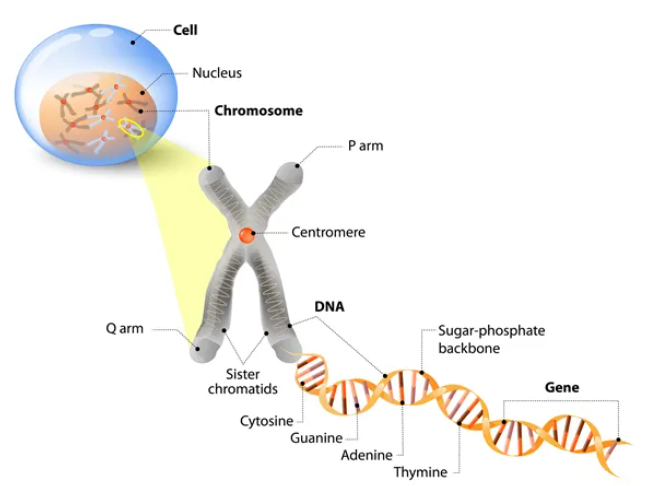Table of Contents
What is a Gene?
A gene is the fundamental genetic unit, possessing a gene structure that defines its function. Composed of DNA, some genes act as blueprints guiding the creation of proteins. Yet, not all genes encode proteins. The intricate gene structure and function vary widely in humans, ranging from a few hundred to over two million DNA bases. The monumental Human Genome Project estimated human genes to total between 20,000 to 25,000, shedding light on gene function.
Humans inherit two gene copies, one from each parent. While most genes are universally shared, a small percentage (less than 1 per cent) carries subtle individual differences, termed alleles. These variants in the gene structure underpin unique physical characteristics that distinguish individuals.
Modern Concept of Gene
Mendel, in his breeding experiment, showed that hereditary traits are controlled by genetic determiners called “genes.” Johannsen termed them genes in 1909. De Vries used “pangen,” possibly inspiring “gene.” Old gene definitions focused on phenotype impact without discussing size or chemical makeup.
After Mendelian laws’ rediscovery, cytology connected Mendel’s factors to chromosomes:
- Mendelian factors and chromosomes are solitary in germ cells.
- Factors pair during fertilization.
- They segregate during germ cell formation.
Objection arose since genes outnumbered chromosomes. In 1902, Sutton and Boveri resolved this, seeing chromosomes as gene carriers. Morgan, with Drosophila melanogaster, noticed 4 chromosome pairs with numerous traits, leading to gene theory.
Theory states:
- Chromosomes bear genes, many per chromosome.
- Genes line up on chromosomes in specific loci.
Chromosomes can appear as “beads on a string” in meiotic prophase. These chromomeres and chromonema linkers are functional.
Salivary gland chromosome banding and amphibian egg chromosomal loops suggest functional discontinuity. Genes aren’t distinct from non-genic material; recombination occurs in both.
Gene Structure Diagram
A gene structure diagram illustrates the arrangement of various components within a gene. It includes coding and non-coding regions, such as exons and introns, that comprise the gene’s DNA sequence. Promoter and enhancer regions control gene expression, while the transcription start site initiates gene transcription. The diagram showcases how genes comprise different segments with specific functions, contributing to the synthesis of proteins and regulatory processes. The gene structure diagram provides insights into the organization and functionality of genes in the context of molecular genetics.

Types of Genes
Genes can be categorized into various types. Several types of genes present in eukaryotes include:
- Complementary Genes
- Duplicate Genes
- Polymeric Genes
- Modifying Genes
- Lethal Genes
- Moveable Genes
Gene Structure
Genes have a specific gene structure that is written in the DNA code. DNA consists of building blocks called nucleotides, made up of a sugar (deoxyribose), a phosphate group, and one of four nitrogen bases: Adenine (A), Thymine (T), Cytosine (C), or Guanine (G). These bases pair up—A with T and C with G—forming a double helix. This arrangement is crucial for DNA replication. Genes are segments of this code, with sequences like ATCG. Genes aren’t only about proteins; they also contain introns (repeats) and exons (protein-coding parts), both involved in gene function regulation. This complex gene structure determines how a gene functions.
Also Check For Relevant Topics:
Gene Functions
Genes play a vital role in controlling various processes within living organisms. Function of Genes includes:
- Protein Synthesis: Genes provide instructions for creating proteins essential for the structure and functioning of cells and tissues.
- Enzyme Production: Many genes are responsible for coding enzymes that facilitate chemical reactions in the body, aiding in digestion, metabolism, and other essential processes.
- Cellular Signaling: Genes regulate the production of signalling molecules that guide cell communication, allowing coordinated responses within the body.
- Hormone Regulation: Genes control the synthesis of hormones, which serve as chemical messengers that regulate bodily functions and maintain homeostasis.
- Development and Growth: Genes influence the growth and development of an organism, including processes like cell division, tissue differentiation, and organ formation.
- Immune Response: Genes produce immune system components that defend against infections and diseases.
- Regulation of Gene Expression: Some genes act as regulators, determining when and how other genes are activated, contributing to the intricate balance of cellular functions.
- Inherited Traits: Genes carry the genetic information that determines inherited traits, passing genetic characteristics from generation to generation.
Understanding the multifaceted functions of genes is crucial in comprehending the complexities of biological systems and the maintenance of life processes.
Frequently Asked Questions on Genes
What are genes examples?
Our genes contain information that is passed down from generation to generation. For example, genes are why one child has blonde hair like their mother, while their sibling has brown hair like their father. Genes also influence whether some illnesses run in families and whether newborns are male or female.
Where is gene located?
Genes are on microscopic spaghetti-like structures known as chromosomes (pronounced KRO-moh-somes). And chromosomes can be discovered within cells. There are billions of cells in your body.
What is a gene and what is its role?
The gene is regarded as the fundamental unit of inheritance. Genes, which carry the information needed to specify physical and biological features, are passed down from parents to offspring. Most genes encode for distinct proteins or portions of proteins that perform various bodily tasks.
What is the importance of genes?
Genes include instructions that teach your cells on how to function and grow. Cells are the body's building blocks. Every portion of your body comprises billions of cells that collaborate. Genes are organized into structures known as chromosomes.





